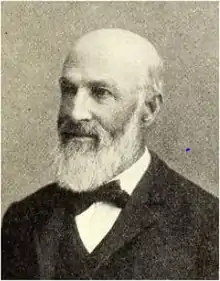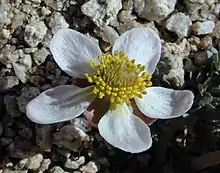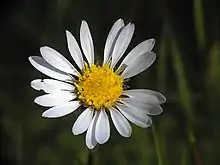Charles Lewis Anderson
Charles Lewis Anderson was an American medical doctor who, in addition to the practice of medicine, made important contributions to fields of natural history, especially botany. Educated in Indiana, he spent most of his professional life in the upper Midwest and West (Hennepin Co., Minnesota; Carson City, NV; and Santa Cruz, CA). Many plants collected by him were subsequently named in his honor. He wrote about local natural history, and actively engaged in public service in places where he resided.
Charles Lewis Anderson | |
|---|---|
 | |
| Born | September 27, 1827 Roanoke County, Virginia, U.S, |
| Died | December 22, 1910 (aged 83) Santa Cruz, California, U.S. |
| Known for | Early Nevada and California botanist |
| Spouse(s) | Merial Howe Anderson |
| Scientific career | |
| Fields | Botany and other areas of natural history |
| Signature | |
Biographical
He was born in Roanoke County, Virginia September 27, 1827.[1][2][3] His family relocated to Morgan County, Indiana, when he was 10, and his further education took place in that state. He attended Franklin College and DePauw University (known, then, as Indiana Asbury University), and obtained his medical credentials from the latter in 1852.[4][2][3] He then spent 10 years engaged in medical practice in Hennepin County, Minnesota.[3] In 1862 he relocated to Carson City, Nevada (to be joined a year later by his wife and two daughters). He resided in Carson City for four years,[1] then moved with his family to Santa Cruz, California, where he lived until his death in 1910.[4]
During his college years he developed a strong interest in natural history, especially botany.[2][3] His lifetime income was derived principally from medical practice, but he devoted much effort to the study of botany and other aspects of natural history.
Hennepin County, Minnesota
In 1852 he was one of the earliest physicians to set up medical practice in the region that later became Minneapolis.[5][6] The St. Anthony and Minneapolis Union Medical Society was organized in 1855 with Dr. C. L. Anderson as vice-president.[6] He was active in geological and geographical exploration to the west of the Minneapolis area, locating the Kandiyohi Lakes region, and going as far as the present states of Montana and Idaho.[5] He was sometimes referred to as a geologist, and co-authored a report to the Minnesota state government suggesting a geological survey for the state,[7] but the governor was reluctant to do so at that time.[8]
He helped build a public school and served as the first school superintendent of Hennepin County.[1]
Henry David Thoreau, in 1861 (the last year of his life), seeking a more healthful climate, visited the Minneapolis area for about two weeks. He wished to study the flora and fauna of the region, and was accompanied most of that time by Dr. Anderson, whom Thoreau had sought out when learning of his extensive knowledge of the area's natural history.[6][9]
In March, 1862, Anderson left Minnesota. As related by Shutter[6] (p. 359): "He had many friends, and his departure was deeply regretted."
Carson City, Nevada
After settling his wife and two daughters in Beloit, Wisconsin, he commenced the arduous trek to Carson City. While travelling, and after arriving and establishing a practice there, he wrote frequently to his wife.[3][10] In one letter he wrote:
The height of my ambition is to have a pleasant quiet cottage of 5 or 6 rooms, one for a library where we could read and converse evening or enjoy other amusements, a small garden of vines and fruits with a few choice flowers. A business that would yield a comfortable living and a few select friends to come and see us. Out of debt so that what I earned I could call my own, my motto then could be to "owe no man anything." In the study of Nature, and Nature's God, we would be enabled to live nearer to Him, and with greater happiness to ourselves."[11]
His wife and daughters, braving the rigors of a wagon train journey, joined him in August, 1863.[3]
His four years in Nevada saw him travelling widely around Carson City, discovering and collecting many plant species new or only poorly known to science.[2][10]
Public service included being superintendent of schools in Ormsby Co., and surgeon-general under Nevada's governor.[3][1]
Santa Cruz, California
Dr. Anderson spent 10 years in Minneapolis, 4 years in Carson City, then 43 years, the rest of his life, in Santa Cruz. In each case he joined a community in its infancy, and was a significant contributor to its maturation.
In Santa Cruz he served local schools, and helped found the Santa Cruz City Public Library in 1868, serving as president of its first board of trustees.[12] Subsequently, he oversaw the funding of a Carnegie library building.[13] He was a "United States Examining surgeon for pensions", and served as "president of the City Board of Health"; he was also active in the Sons of Temperance, Chautauqua Literary and Scientific Circle, and Freemasonry.[4]
Conservation
Anderson was an early proponent of wildlife conservation. He wrote that the "shooting of birds to get an exact measurement of the different parts of their bodies, the color, etc., is practiced too much and becomes a cruelty. A spyglass, close observation, and a ready ear would give all the information we need in most cases."(p. 144[1]) He acknowledged his indebtedness to two ornithologists who provided him with information for his essay on Our Feathered Songsters, but commented parenthetically "I only wish they would not use their little guns so much."(p. 145[1]) He also remarked negatively on catching trout in freshwater streams ("they are more beautiful there than in our fish basket"[14]
Logging of coast redwoods was well underway in the later 1800s along the central and northern California coast. In his 1879 booklet [14] Anderson wrote of his concerns:
REDWOOD FORESTS . . . Although the supply of timber is very great in the mountains it cannot be considered inexhaustible. The rapid increase of population and consequent demand for building material and fuel will in time lead to the denudation of the region nearest the large cities. Consequently a preservative policy should be adopted at an early date by which a portion of the land should retain, at least, the younger for future use. It would indeed be a wise policy to enforce a law to this effect if it cannot be done otherwise. The general future good of our State requires it . . .
Death
Extract from an obituary in the Santa Cruz Sentinel of 23 Dec 1910:
"Dr. C. L. Anderson, one of the most respected of Santa Cruz County's old pioneers, passed away at the advanced age of 83 years and 8 months . . . leaving his widow and their three children, all of this county . . . The cause of the death was paralysis, brought on by old age. . . . The doctor, who for many years enjoyed an enviable medical practice in this community, was a man of scholarly attainments . . . was a man of exemplary character, of an even disposltion, quiet in his ways, unpretending, self-sacrificing, of a very kindly nature. Santa Cruz was made much richer by his presence amongst us, for he lived a life of service, caring little for pecuniary emoluments.[4]
Collecting, and eponymous scientific names
Flowering plants
During the period 1862 - 1867, when Anderson lived in Nevada, he collected many specimens of flowering plants, which he sent to Asa Gray's herbarium for analysis. According to Tiehm,[15] 34 of the plants collected in Nevada became type specimens (as did at least one, collected later, when he lived in Santa Cruz, CA;[16] namely, Arctostaphylos andersonii A.Gray).



Many binomial scientific names honor an Anderson; the ones below honor Charles Lewis Anderson, and are currently (2020) accepted (see references and ITIS[17]). Each name is followed by the (plant family name), a common name, and the region where Anderson collected the type specimen.
Photographs of each flowering plant may be found at CalPhotos,[18] and further information is available at CalFlora.[19]
- Arctostaphylos andersonii A.Gray[20] (Ericaceae), Santa Cruz manzanita, near Santa Cruz, CA
- Astragalus andersonii A.Gray[21] (Fabaceae), Anderson's milkvetch, near Carson City, NV
- Cirsium andersonii (A. Gray) Petr[22] (Asteraceae), Anderson's thistle, Sierra Nevada [Original name: Cnicus andersonii (A. Gray)[23]]
- Delphinium andersonii A.Gray[24] (Ranunculaceae), Anderson's larkspur, eastern Sierra Nevada
- Lupinus andersonii S.Watson[25] (Fabaceae), Anderson's lupine, near Carson City, NV
- Lycium andersonii A.Gray[26] (Solanaceae), Anderson thornbush, S.E. NV
- Oreostemma alpigenum var. andersonii (A. Gray) G.L. Nesom[27] (Asteraceae), Anderson's aster, near Carson City, NV (Original name: Aster andersonii (A.Gray) A.Gray[28]
- Prunus andersonii A.Gray[29] (Rosaceae), desert peach, eastern Sierra Nevada
- Ranunculus andersonii A.Gray[30] (Ranunculaceae), Anderson's buttercup, eastern Sierra Nevada
- Trifolium andersonii A.Gray[31] (Fabaceae), Anderson's clover, near Carson City, NV
Marine algae
After settling in Santa Cruz, Anderson collected many specimens of marine algae. He sent them to W. G. Farlow, a prominent phycologist, who wrote of "the many interesting species discovered by Dr. Anderson",[32] and named some in Anderson's honor.[2] The following is currently (2020) an accepted name:[33]
- Haplogloia andersonii (Farlow) Levring[34][35] (Chordariaceae), hairy brown seaweed, Santa Cruz, CA
Publications
- Anderson, C. L. 1861. Report on Geology and Plan for a Geological Survey of the State of Minnesota. State of Minnesota. Retrieved from the University of Minnesota Digital Conservancy, http://hdl.handle.net/11299/59459
- Anderson, C. L. 1871. A Catalog of Nevada Flora. Third Biennial Report of the State Mineralogist. p. 116-128.[36]
- Anderson, C. L. 1879. Santa Cruz for Homes: The Climate, Botany, Geology and Health of Santa Cruz and Vicinity. https://babel.hathitrust.org/cgi/pt?id=hvd.32044106424104&view=1up&seq=13
- Anderson, C. L.(Ed). 1890. Catalog of Flowering Plants and Ferns of Santa Cruz County, California. Santa Cruz Surf Print.[37]
- Anderson, C. L. 1892. Chapter VI:[1] Geology or the Ancient History of Santa Cruz, pp 90–97
- Anderson, C. L. 1892. Chapter VII:[1] The Gardens of the Seashore, pp 98–110
- Anderson, C. L. 1892. Chapter VIII:[1] The Fishes of Monterey Bay, pp 111–117
- Anderson, C. L. 1892. Chapter IX:[1] Catalogue of Flowering Plants and Ferns of Santa Cruz County, California, pp 118–128
- Anderson, C. L. 1892. Chapter X:[1] Lists and Notes of Native and other Grasses Found Growing Wild in Santa Cruz County, pp 129–135
- Anderson, C. L. 1892. Chapter XII:[1] Our Feathered Songsters, pp 144–150
- Anderson, C. L. 1894. Some New and Some Old Algae but Recently Recognized on the California Coast . . . . Zoe 4(4):358[38]
References
- Harrison, E. S. (1892). History of Santa Cruz County, California. San Francisco, Cal.: Pacific Press Publishing Co. Retrieved Apr 10, 2020.
- Jepson, Willis Linn (1929). "The Botanical Explorers of California-V. Charles Lewis Anderson". Madroño. 1: 214–216. Retrieved Mar 15, 2020.
- Reifschneider, Olga (1964). Biographies of Nevada Botanists 1844-1963. Reno, NV: Univ. of Nevada Press. pp. 34–37.
- "Dr. L. C. Anderson dies at the age of 83 years". Santa Cruz Sentinel. Dec 23, 1910. p. 1,5. Retrieved Mar 28, 2020.
- Stevens, John H.; Robinson, Marshall (1890). Personal Recollections of Minnesota and its People, and early history of Minneapolis. Minneapolis, Minnesota: Tribune Job Ptg. Co. Retrieved Apr 10, 2020.
- Shutter, Marion Daniel (1923). History of Minneapolis. Minneapolis: S. J. Clarke Publishing Co. Retrieved Apr 8, 2020.
- Anderson, C. L.; Clark, Thomas (1861). Report on Geology and Plan for a Geological Survey of the State of Minnesota (PDF). St Paul: Wm. R. Marshall. Retrieved Apr 11, 2020.
- Clements, J. Morgan (1903). The Vermilion iron-bearing district of Minnesota, with an atlas. Washington, DC: Govt. Print. Office. p. 66. Retrieved Apr 11, 2020.
- Straker, Robert L. (1941). "Thoreau's Journey to Minnesota". The New England Quarterly. 14 (3): 549–555. doi:10.2307/360492. JSTOR 360492.
- Blakely, Larry. "Anderson's Buttercup . . ". Who's in a Name?. Retrieved Mar 23, 2020.
- Reifschneider, Olga (1966). "Dr. Anderson in Wild & Wooly Carson City. Nevada". Nevada Highways and Parks. 26 (3): 16.
- "First Librarian". Santa Cruz Sentinel. Aug 21, 1938. p. 30. Retrieved Apr 11, 2020.
- "Carnegie". Santa Cruz Evening Sentinel. Jan 2, 1902. p. 3. Retrieved Apr 11, 2020.
- Anderson, C. L. (1879). Santa Cruz for Homes: Climate, Botany, Geology, and Health of Santa Cruz and Vicinity. San Francisco: Wallace W. Elliott & Co. Retrieved May 25, 2020.
- Tiehm, Arnold (1996). Nevada Vascular Plant Types and Their Collectors. Bronx, New York: New York Botanical Garden. ISBN 0-89327-401-1.
- Thomas, John H. "The History of Botanical Collecting in the Santa Cruz Mountains of Central California" (PDF). trees.stanford.edu. Stanford University. Retrieved Apr 6, 2020.
- ITIS. "ITIS". ITIS. Retrieved Mar 16, 2020.
- "CalPhotos". CalPhotos.
- "CalFlora". CalFlora. Retrieved Mar 8, 2020.
- Gray, Asa (1876). "Miscellaneous Botanical Contributions". Proc. Amer. Acad. Arts. 11: 83. Retrieved Mar 6, 2020.
- Gray, Asa (1864–1865). "Characters of Some New Plants of California and Nevada . . ". Proc. Amer. Acad. Arts. 6: 524. Retrieved Mar 6, 2020.
- Petrak, F. (1911). "Beiträge zur Kenntnis der mexikanischen und zentral-amerikanischen Cirsien". Bot. Tidsskr. 31: 68. Retrieved Mar 7, 2020.
- Gray, Asa (1874). "Contributions to the Botany of North America". Proc. Amer. Acad. Arts. 10: 44.
- Gray, Asa (1887). "Delphinium, an attempt to distinguish the North American Species". Bot. Gaz. 12: 50, 53. 12 (3): 53. Retrieved Mar 7, 2020.
- Watson, Sereno (1871). United States Exploration of the Fortieth Parallel. Vol. V. Botanyi (PDF). Washington, DC: Govt. Printing Office. Retrieved Mar 7, 2020.
- Gray, Asa (1868). "Characters of New Plants of California and Elsewhere . ". Proc. Amer. Acad. Arts. 7: 388.
- Nesom, G. L. "Oreostemma alpigenum (Torr. & A. Gray) Greene var. andersonii (A. Gray)". Jepson eFlora. UC Berkeley. Retrieved Mar 7, 2020.
- Gray, A. (1868). "Characters of New Plants of California and Elsewhere . . ". Proc. Amer. Acad. Arts. 7: 352. Retrieved Mar 3, 2020.
- Gray, Asa (1868). "Characters of New Plants of California and Elsewhere . . ". Proc. Amer. Acad. Arts. 7: 337. Retrieved Mar 7, 2020.
- Gray, Asa (1868). "Characters of New Plants of California and Elsewhere . . ". Proc. Amer. Acad. Arts. 7: 327. doi:10.2307/20179569. JSTOR 20179569. Retrieved Mar 7, 2020.
- Gray, Asa (1865). "Characters of some New Plants of California and Nevada . . ". Proc. Amer. Acad. Arts. 6: 522. Retrieved Mar 7, 2020.
- Farlow, W.G. (1889). "On Some New or Imperfectly Known Algae of the United States". Bulletin of the Torrey Botanical Club. XVI (I): 1. Retrieved Mar 15, 2020.
- ITIS. "Haplogloia andersonii". Retrieved Mar 15, 2020.
- UC Jepson Berkeley. "Haplogloia andersonii (Farlow) Levring". DECEW'S GUIDE. Retrieved Mar 15, 2020.
- "hairy brown seaweed". Wildflower Search. Retrieved Apr 6, 2020.
- "Third Biennial Report". Nevada State Library, Digital Collections.
- Anderson. Catalog. Hathitrust. [Santa Cruz. Retrieved Mar 31, 2020.
- Anderson, C. L. "Some New and Some Old Algae ..."
- IPNI. C.L.Anderson.